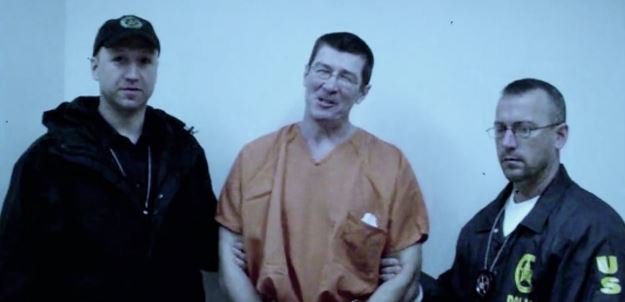Richard Lee McNair is one of the world’s best-known prison escapees. Some see him as a Robin Hood-esque man, a charming individual with a dazzling smile to dance around law enforcement.
This is true. Many of the guards and officers who have worked with McNair say the same thing: “You’d probably like him.”


But such a viewpoint neglects the lengths to which McNair went in the past to secure his freedom.
Born in Oklahoma
McNair was born in December 1958 in Duncan, Oklahoma. He was the oldest of four brothers and the son of a jewelry store manager. Six feet tall, wiry, and with a charming smile, he was seen as friendly and attractive.
As he grew up, he eventually became a military policeman and a sergeant in the U.S. Air Force, stationed at Minot Air Base in North Dakota. He also became an undercover officer with the local police force’s drug squad.
Then, McNair started stealing things like electronics and carpets. He stashed them in a storage locker, rented under a false name.
But he would become far more than a burglar. Before long, he would become a murderer.
The Minot Grain Elevator
On November 17, 1987, things took a much darker turn. McNair was involved in a robbery at the local Farmers Union Minot grain elevator, located on the outskirts of town. He was armed with a five-shot .38 revolver.
At around 10 pm, he was interrupted by Richard Kitzman, a Minot local who worked at the grain elevator. Kitzman had been called in to load grain onto a waiting semi.
McNair didn’t even say he was there. As Kitzman walked through some double doors, McNair shot at him from behind. The shot smashed through a window and grazed Kitzman’s temple, knocking him to the floor, where he curled up in a fetal position and played dead.
McNair shot at Kitzman point-blank four more times, hitting him twice more on the leg and the arm. With the cylinder emptied, he ran, reloading his gun.
Outside, he saw a semi and rushed towards it. He jumped on the running board and saw a Minneapolis truck driver, Jerome Theis, Kitzman’s long-time friend.
Theis was absent-mindedly eating ice cream as he waited to load. McNair held his .38 up again and emptied the gun, shooting Theis five times, point blank. One bullet hit him between the eyes and killed him instantly. He also had several other fatal wounds.

For a while, McNair got away with his crimes. Until he slipped. Several weeks later, McNair fell behind on his storage locker rental payments. The owner opened it – and called the police. Inside, police found spent bullet casings from the grain elevator burglary, which he had kept as a trophy.
The police then called McNair and asked him to come into work to discuss something. When he arrived the next day, he was arrested.
The Lip Balm Escape
By then, it was February 1988, and McNair was held at the Minot police station, handcuffed to a chair by the wrist.
For McNair, escape was a relatively simple process. He opened the desk drawer and pulled out some lip balm. He then greased his wrist and slipped his arm free. Then, he pushed two officers over and ran outside, past the receptionist, where he stole a car.
Police later cornered and captured him when he jumped from a third-floor window of a building near the Minot hospital.
While awaiting his trial for the grain elevator burglary and murder, McNair chipped out two cinderblocks in his cell. Behind here, he stored a flashlight, along with sheets and towels that he was going to use to make a rope.
Authorities discovered his plot just in time and confiscated the items. From now on, they would keep a much sharper eye on the otherwise charming inmate.
The Trial
Ballistics matched the spent bullets at the grain elevator – which McNair had kept as a trophy – to his .38 revolver. Incredibly, Kitzman survived his three bullet wounds and was able to testify.
Kitzman couldn’t believe McNair would possibly need to kill him, because he hadn’t even noticed he was there. McNair was a man who had killed his friend in cold blood, simply to make sure he left no witnesses.
After pleading guilty, he was convicted. He received life terms for murder and attempted murder at the Bismarck State Penitentiary.
Those convictions embedded him in a sequence of prisons from which he would repeatedly slip away.
The 1991 Escape Attempt
In 1991, McNair and another prisoner planned an escape attempt. They worked in Roughrider Industries, a manufacturing warehouse inside the prison grounds for inmates. Here, the two men had removed most of the security fixtures from an air vent that led outside.
All was going well, and they were very nearly ready to escape – until a fellow prisoner went to the guards and tipped them off. On Sunday, April 21, 1991, Steven Scott, the chief of prison security, foiled their escape attempt, and McNair and his accomplice were placed in isolation and pre-trial detention.
During this time, Scott believed that McNair wanted to die and was expecting to be shot by the tower guards during his escape attempt. Perhaps this attitude – do-or-die – underlined the bravado with which he would escape prison twice more.
At his trial in prison, McNair entered no evidence and was found guilty of attempting to escape. He was sentenced to a further three years in jail, on top of his life sentences.
McNair became an ideal prisoner, known for his good behavior. He even helped run programs aimed at crime prevention among the youth. But all this was just a mask. And only a little over a year later, that mask would come crashing down.
The Ten Commandments Escape
McNair presented an immediate problem. He was an inmate serving a life sentence and someone considered dangerous. But he had also been a military policeman, and knew how to observe routines or weak points – and exploit them.

Most dangerously of all, he was extremely likable. While he was being held in the North Dakota State Penitentiary, McNair made his move.
On October 9, 1992, the prison was showing the film The Ten Commandments in the education room.
This film, made by Cecil B. DeMille in 1956, is about the life of Moses and is one of the longest-running films ever made by Hollywood. Its runtime is 3 hours and 40 minutes.
McNair was sure that nobody else would want to sign up to watch it. And that the guards wouldn’t patrol inside the room. And that the movie’s long runtime provided ample time for escape. He was right.
Along with two other inmates, Michael Phelps and Jeffrey Siebert, McNair removed the security fixtures, including ceiling tiles, from the ventilation duct. When they were ready, they scrambled through the system and ended up in an outside section of the facility.
Then they climbed up a fence post, crossed the roof of the visitors’ room, and jumped down 15 feet to the ground below. And thus, they were free.
On the Run
But staying free is much more difficult than breaking out. Within a few days, both Phelps and Siebert had been recaptured. McNair, however, was nowhere to be found.
In fact, McNair managed to stay on the run for around ten months. He dyed his hair, had multiple fake IDs, and took odd jobs, staying in motels in small midwestern towns as he made his way south, burglarizing and stealing cars.
Everyone who knew McNair knew he was a smooth talker, someone calm under pressure, and highly manipulative. He had no problem earning the trust of multiple people during this time.
By July 1993, McNair was living in Grand Island, Nebraska, under the alias Robert Jones. He tried to burglarize a car dealership, and police caught him with a stolen van, a stun gun, and a police scanner. He was swiftly whisked back to the North Dakota State Penitentiary.
Moved Around U.S. Prisons
Under a prisoner swap deal, McNair was then sent to Oak Park Heights in Minnesota. It was a top-security facility, mainly located underground. But McNair proved troublesome and organized prisoner strikes.
So, by 2001, he was sent to a federal prison. Because of his reputation, he was placed in Supermax in Florence, Colorado. A few years later, having built a reputation for good behavior, he was moved again, this time to Pollock, Louisiana.
A relatively new prison, Pollock had only been open for five years, and nobody had ever escaped. Yet.
The Mail Bag Escape
Pollock was where the prison break that made McNair most famous of all occurred on April 5, 2006.
He hadn’t been in Louisiana long. He arrived in September 2005, and by December was working in a prison labor area where inmates repaired and recycled postal bags. Innocent enough, right?
But McNair spent months quietly developing his escape plan – a plan that would be both incredibly simple and devastatingly effective. McNair piled up a stack of repaired bags on a pallet, ready to be sent off as usual.
However, hidden in this pile was a narrow ‘escape pod’, just big enough for his body. He added a breathing tube and placed the repaired bags – and his ‘escape pod’ – on a pallet bound for an off-site warehouse.
Then, he hid himself inside and waited. Before long, the pallet was shrink-wrapped and forklifted out of the compound – with McNair hidden inside.
Once it was dropped outside the fence, McNair waited for a lull when the staff were all on their lunch break. Then, he simply cut himself out and walked away.
The escape was ingenious – and for people like Richard Kitzman, who had almost been murdered by McNair, very worrying. A national manhunt began in earnest.
A Close Call
Perhaps the most incredible part of McNair’s escape occurred just a few hours later, just after 4 pm.
A Ball police officer stopped him as he was running along railroad tracks. Suspicious, he called the escapee over. McNair obliged.
What followed is an almost unbelievable example of calmness under pressure, as the officer asked McNair questions and McNair replied – extremely convincingly – that he was simply a jogger running back from his post-Katrina roofing project, living in a local hotel.
At one point, the officer even told McNair, “Word is, we got an escapee.”
“Oh, s###!” replied McNair. “Where from?”
“Prison.”
“There’s a prison here?”
And then a little later, the officer told him, “You wouldn’t believe what them guys do. They got years and years to think about how they’re going to do it.”
“I promise you I’m not no prison escapee.”
“You’d have done run by now,” replied the officer laughing.
A little later, the police officer let him go. Later, it became clear that the police had only an outdated, low-quality photo to compare with him and a poor description from prison officials.
Even though McNair closely matched the description, his convincing character and knowledge of the local area led the policeman to conclude that this person was not the escapee he was looking for. It was an opportunity missed, and McNair slipped away once again.
On the Run in Canada
This time, McNair went international. Within weeks, he had crossed the northern border into British Columbia, Canada.
Here, police came close to identifying him. Royal Canadian Mounted Police (RCMP) officers in Penticton reportedly questioned a man matching McNair’s description in late April 2006.
He jumped from the stolen car he was in and ran, and only days later did police realize the vehicle contained his fingerprints and a camera full of self-portraits – evidence he’d been busy fabricating IDs.
All the time, McNair dropped unnecessary and intriguing clues, taunting and baiting the investigators trying to follow his trail.
Caught by the RCMP
After more than 18 months on the run and after traveling across almost the entire country of Canada, McNair’s luck finally ran out near Campbellton, New Brunswick.
In October 2007, an off-duty RCMP constable spotted a suspicious cube van and noted its plates – a small act that set in motion a routine patrol stop the following day, just before noon on October 25, 2007.
The traffic stop ended in a short pursuit on foot and McNair’s arrest without serious incident. It didn’t take long before McNair, now with a full beard and mustache, was under Canadian lock and key.
Returned to U.S. custody, McNair was sent back to Louisiana on November 9. He later faced additional federal charges for the Pollock escape and was sentenced to an extra 30 months, on top of the life terms he already served for murder and attempted murder.
McNair is still in prison – so far as we know. But his story continues to intrigue people all around the world.
Sources
https://www.nbcnews.com/id/wbna21485118
https://byronchristopher.org/tag/richard-lee-mcnair
https://www.newyorker.com/magazine/2006/10/09/escaped
https://www.trillmag.com/life/the-remarkable-story-of-the-murderer-richard-lee-mcnair












Leave a comment